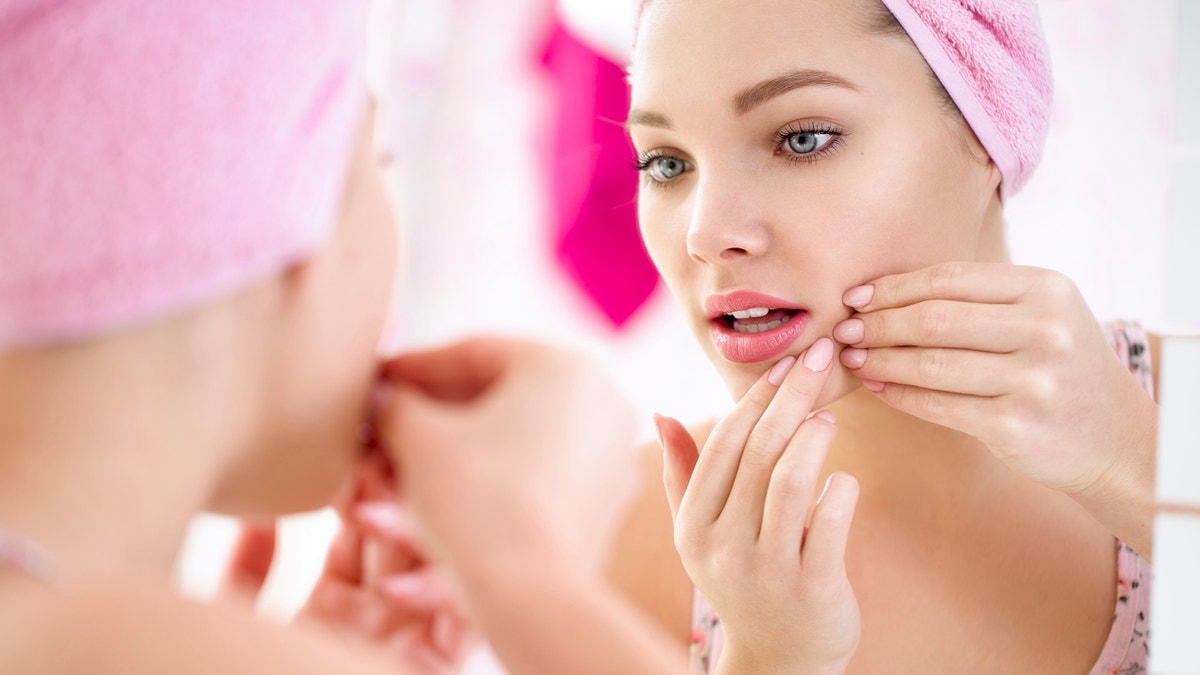
Young teenage girl looking pimple on her face in a mirror, concept problem on skin (iStock)
Acne sucks. But for a condition that affects so many people, there are still a lot of unknowns with it. One of the most controversial: Can what you eat or drink cause you to break out?
Dairy has been one of the most commonly discussed culprits in whether your diet can be to blame. But whether your love of cheese is directly causing your outbreak is still up for debate, as there are plenty of myths about what causes zits.
A growing volume of research suggests the link is there, though. That’s because acne is an inflammatory condition, says board-certified dermatologist, Joshua Zeichner, M.D, director of cosmetic and clinical research at Mount Sinai Hospital. Oil gets trapped inside your pores, clogging them up. This allows bacteria to grow within the follicles, which causes inflammation. That inflammation produces the red bumps on your skin.
Cow’s milk can cause inflammation, too, Dr. Zeichner says. The hormones in milk can react with the testosterone in your own body. This increases the production of sebum in your skin, the oily substance that clogs your pores.
It’s a bit of double whammy: Not only does the bacteria living in your pores cause inflammation, but what you ingest, like milk, can also promote inflammation, making your skin even worse. Plus, milk proteins like whey and casein may also be to blame, though the exact process behind what’s causing it isn’t yet known, says Whitney Bowe, M.D., a board-certified dermatologist in New York City.
That’s why whole milk might be the better choice than skim for your skin: Proteins like whey and casein are often added to skim milk to make it taste less watery, says Dr. Bowe. But both whey and casein release a hormone similar to insulin called IGF-1, which is known to trigger breakouts. In fact, research has shown that bodybuilders and athletes who use whey supplements like shakes and protein bars can suffer from severe acne, she says. (In fact, your workout can actually cause a bunch of annoying skin issues.)
But putting all dairy in this pimple-causing category might be a mistake: Milk and ice cream have been associated with acne, but yogurt and cheese don’t seem to have the same type of effect, says Dr. Bowe. In fact, the probiotics in yogurt can actually help control your breakouts, she says. Researchers aren’t sure as to why that may be, but probiotics are known to calm inflammation, she says, and the fermentation process results in lower levels of IGF-1 than what you would find in milk.
As for cheese, that’s still a mystery, Dr. Bowe says. Hard cheeses do have less lactose than milk does—making them a better choice for people with trouble digesting dairy—but there’s no evidence to suggest that lactose content plays a role in breakouts. More research needs to be done to determine why cheese seems safer.
Regardless, if you consistently break out after you eat dairy-heavy foods, it might be worth cutting dairy from your diet to see how your skin reacts. Sometimes it takes a month or longer to see any kind of impact on your skin, Dr. Bowe says.
If it’s too difficult to completely cut all dairy right off the bat, you can try a more gradual approach. Start by substituting your go-to milk with almond or soymilk. Then, if the breakouts persist after a few months, you can try cutting out cheese to see if it makes more of a difference.
Still, it’s likely that a diet change isn’t going to be the final solution for you, Dr. Bowe adds. Removing dairy from your diet usually isn’t enough to cure your acne on its own—though it may help reduce your breakouts. However, lots of other factors could be at play, like genetics, your skin-type, stress, sleep, and your skincare habits.
So if your breakouts are frequent and consistent, you need to bring in the tried-and-true acne treatments, too. Using cleansers or creams with benzoyl peroxide or salicylic acid while you’re making your diet change is your best bet for clearer, smoother, skin, says Dr. Zeichner. If you’re dealing with oily, clogged pores, these products are a great place to start.
